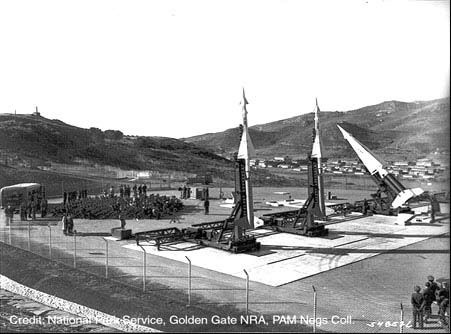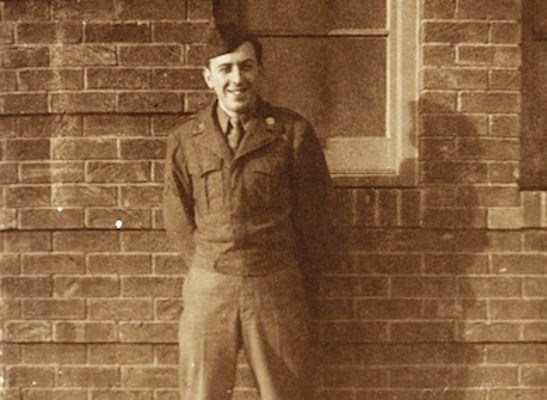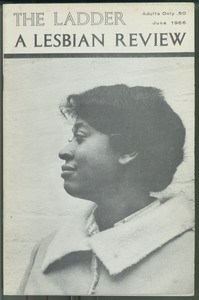Last updated: February 19, 2025
Article
Cold War, Lavender Scare, and LGB Activism

PARC, Golden Gate National Recreation Area
The Lavender Scare
In 1947, President Truman passed an executive order establishing a loyalty program for federal employees. This meant anyone seen as displaying immoral or disgraceful conduct was a target.1 The language of this executive order was used to single out LGB people and separate them from federal service. They were perceived as a threat to the nation’s wellbeing, even though there was no evidence to support this. A memo written to the Secretary of State in 1950 stated that no evidence had been found to support the claim that LGB people were any threat to national security, and yet “the tendency toward character weaknesses has led us to the conclusion that the known homosexual is unsuited for employment in the Department.”2
Additionally, some people believed LGB people were part of a global conspiracy. This theory also included the threat of communism.3 Many thought if you were openly gay, you were more suspectable to Soviet blackmail. In 1953, President Eisenhower signed Executive Order 104050 which effectively banned LGB people from federal employment. Because of this, thousands of government officials suffered irreparably damaged, losing their jobs and reputations.4 This is now known as the Lavender Scare.
“There were people of goodwill, who would help us, but we could not do anything naughty like having picket signs or parades. ‘Why, only Communists would do things like that.’ And so they started calling us communists, not because they had even the faintest shred of evidence for this accusation, but because we were saying such daring things. That's what communists do: they create waves...” -- Chuck Rowland, Mattachine Society Founding Member. 5
Creating Resistance
After WWII people became more aware of LGB rights in the United States. In 1950, five men came together in Los Angeles to form a secret group called the “Fifth Order.” This group was led by Harry Hay, Chuck Rowland, Dale Jennings, Bob Hull, and Rudi Gernreich. This group would ultimately expand to become the Mattachine Society, the first large scale LGB organization in the United States. Both Harry Hay and Chuck Rowland had previous communist affiliations, so the organization was founded with those ideals. The Mattachine Society's mission was, “to ‘unify homosexuals‘ [and] to erase from our law books the discriminatory and oppressive legislation…”6 The founders also recognized that there was an LGB culture that should be celebrated. In the following years the organization began to grow.
In 1952 a group of Mattachine members founded ONE Magazine and Inc. The group wanted to share important information they were discussing with LGB people around the country. The FBI kept tabs on both Mattachine and ONE Inc. The U.S. Post Office Department would not allow ONE Magazine to be sent through the mail because it was “obscene material”. One Inc. sued and in 1958 the Supreme Court extended the right of free speech to the gay press, marking the first LGB rights victory in the Supreme Court. Many members wrote under pseudonyms out of survival. Stella Rush, a bisexual woman, worked for the civil service from 1950 to 1971. In order to protect her identity and career, she wrote for ONE using the pen name Sten Russell.
She said, “I was in civil service, and at that time, boy, practically all you had to do was point at someone... And, well, in the fifties, with McCarthy and the witch hunts... all they had to do was make accusations. At least that’s the way it felt at the time..”7
Divisions and Expansion
The risks of being associated with communism in the 1950s were significant. As the organization grew beyond San Francisco, new leaders emerged. Amongst them was Hal Call, a prominent voice in the Bay Area: who opposed Mattachine’s communist origins. He believed the organization should function democratically, and focus on teaching LGB people how to assimilate in order to survive. He said: ”Foremost in our minds was the fear of being found out, having a heavy finger pointed at us, and being just shattered by accusations and innuendo. Our association of the Mattachine with former communists would make us communist sympathizers and McCarthy could do an axe job on us...”8 By 1957, Conservative members eventually took control of the Mattechine Society in San Francisco.

Library of Congress
Kameny’s Mattachine Society was totally separate from the conservative branch in the West. Kameny said, “The movement of those days was a very unassertive, apologetic, defensive kind of structure. Not taking strong positions. Giving a hearing to everybody[...] We characterized ourselves within the movement as an activist militant organization.”10 Hal Call sent many letters sharing his grievances about the use of the Mattachine name, but the success of the Washington D.C. offset quieted objection. In 1965, Frank Kameny organized a picket in front of the White House. One of the first organized demonstrations for LGB rights. He went on to protest the discrimination of LGB people in the US for 14 years. Kameny also wrote many articles sharing the importance of civic engagement and protesting, in ONE Magazine and The Ladder.

ONE Archives at the USC Libraries
Civic Change
The Ladder was the first periodical to be founded by a lesbian organization: the Daughters of Bilitis’s (DOB), based in San Francisco. DOB was founded in 1955 as a small social club for lesbians to gather safely. Eventually it grew into a national network of activist organizations with local chapters all over the country. By 1966, New York City Chapter Vice President, Ernestine Eckstein pushed DOB to become more politically engaged. She participated in the 1965 picket at the White House. The Ladder began publishing many articles on the issues of militancy in the movement, the Lavender Scare, and demonstrating. One article listed the pros of picketing as protest, stating: “For three years the CSC (Civil Service Commission) had been explicitly refusing to meet with spokesmen for the homosexual community… After the picketing the CSC agreed to a meeting.”11
The 1950s and 1960s saw a real turning point for LGB organizations and collective action. The fear and paranoia of Cold War communism corrupted many. The Nike Missile site in the Marin Headlands was a physical representation of that fear. The mistrust and discrimination that gay and trans people faced was another example of that sentiment.
On July 3rd 1975 the Civil Service Commission announced that gay people could no longer be fired from federal employment because of their sexuality. Frank Kameny said of the new policy, “So that, that’s one battle, one book, that has nicely been closed and put on a shelf as a complete success.”12 In 1998 that discrimination was banned from federal employment.
Sources:
1-4 Naoko Shibusawa. “The Lavender Scare and Empire: Rethinking Cold War Antigay Politics.” Diplomatic History, Vol. 36, No. 4 (September 2012), pp. 723-752.
5 Marcus, Eric. “Chuck Rowland.” Making Gay History, 2020, makinggayhistory.com/podcast/episode-1-7.
6, 8 Sears, James. Behind the Mask of the Mattachine. Routledge, 2006.
7 “Stella Rush (‘Sten Russell’).” Making Gay History, 26 Dec. 2018, makinggayhistory.com/podcast/stella-rush-sten-russell.
9-10, 12 Marcus, Eric. “Episode 05 — Frank Kameny.” Making Gay History.
11 “Picketing: The Pros and Cons.” The Ladder May, 1966. P. 19.
